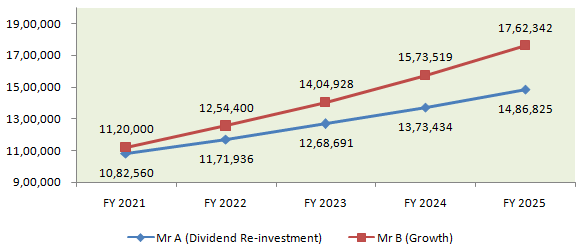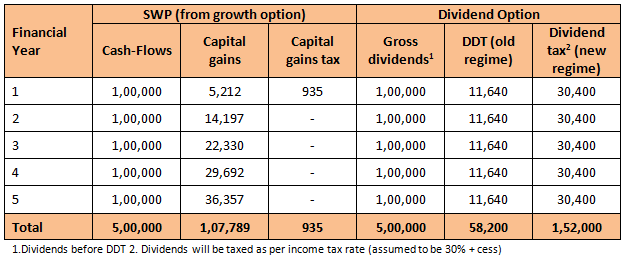Implications of 2020 Budget: Growth versus Dividend Option of mutual funds

For the last 20 years (except for a brief period in FY 2003) dividends were tax free in the hands of the investors, but the company paying dividends had to pay dividend distribution tax (DDT) before giving dividends to investors. In the 2020 Budget, the Finance Minister abolished DDT and moved back to the classical system of taxing dividends i.e. taxing dividends in the hands of the investors. From the next financial year onwards, dividends will be added to your income and taxed as per your income tax slab.
Suggested reading – Avoid 6 common tax planning mistakes
Why did the Government make this change?
Dividend Distribution Tax is considered a regressive tax because the same income is taxed twice, first as corporate tax and then as dividend distribution tax (DDT). The Finance Minister also said that levying DDT increases the tax burden on investors whose tax rates are lower than DDT rate, while it benefits company promoters whose tax rates are likely to be higher than the DDT rate. In the DDT regime, foreign investors too don’t end up getting credit on the Indian withholding tax against tax payable in their home country, and that lowers the rate of return on equity capital. Overall the Government feels that taxing dividends in the hands of investors will be fairer and more revenue efficient than DDT.
Who gains and who loses?
We discussed in brief, the Government’s rationale behind this taxation change to provide readers some context. Our focus at Advisorkhoj is retail investors and we will discuss the change in dividend taxation from the perspective of retail mutual fund investors. Currently, the DDT for equity oriented funds is 11.65%. So if your income tax slab rate is less than 10%, then this change will be beneficial for you. For income in higher tax brackets, this change will result in more taxes.
The DDT for non equity funds (debt funds and debt oriented hybrid funds) is 29.12%. The change in dividend taxation will be beneficial for all investors whose income tax slab is less than 30%. However, for investors in the 30% tax bracket, this change will result in more tax outgo.
You may like to read – How Mutual Fund capital loss tax credits work
What is the impact of this change?
Let us assume you received a gross dividend of Rs 50,000 (before DDT). In the old DDT regime, the AMC would have to pay DDT on this before paying dividends to you. DDT rates were different for equity (11.65% including cess and surcharge) and for debt (29.12% including cess and surcharge) funds. In the new regime, the dividends will be added to your gross taxable income and taxed according to your tax slab. The table below shows the tax consequences in the old and the new regime. Investors in the tax brackets shaded light green pay less tax and those in tax brackets shaded light red pay more tax after this change.

Suggested reading: Know your mutual fund taxation for FY 2019-20
Should you invest in Growth or Dividend Option?
In the wake of the change in dividend taxation, investors should decide whether to invest in dividend option or invest in growth option and get cash-flows through redemptions / SWP. When you redeem or sell units, capital gains tax comes into play.
- Short term capital gains (investment tenures of less than 12 months) in equity funds are taxed @ 15%, while long term capital gains taxed @ 10% for equity funds (for profits in excess of Rs 1 lakh).
- Short term capital gains (investment tenures of less than 36 months) in debt funds are taxed @ income tax rate of the investors, while long term capital gains taxed @ 20% after indexation.
Dividend versus Growth Option
Let us assume, Mr A invested Rs 10 lakhs in the dividend option of a mutual fund scheme for a period of 5 years and Mr B invested Rs 10 lakhs in the growth option of the scheme for the same period. The ROI (annualized return) of the scheme is 10%. For the sake of simplicity in making comparisons between the two options, let us assume that all profits are paid out as dividends at the same rate every year in dividend option, while profits are reinvested in the growth option. Let us further assume that both Mr A and Mr B are in the 30% tax bracket. The table shows, year-wise taxes for both the investors.

You can see that the tax outgo for Mr B is much lower over the entire investment tenure, even though the wealth creation in growth option is significantly more. In growth option, you stand to gain from the twin benefit of power of compounding and lower effective tax rates.
Dividend Re-investment versus Growth
Let us assume Mr A and B invest Rs 10 lakh each in the same scheme on 1st April 2020. Mr A invests in dividend option, pays dividend tax @ 31.2% (including cess) and re-invests the post tax dividends in the same scheme. Mr B invests in Growth Option of the scheme. The chart below shows how much their investment will grow in five years @ 12% ROI. Mr A will pay Rs 2.2 lakhs in taxes, while Mr B will not have to pay taxes till he redeems.

While many investors go for dividend options because they need cash-flows, some investors prefer it because they want to book profits. After this tax change dividends for the purpose of profit booking will have considerable tax consequences for investors in the higher tax brackets. Though we do not recommend profit booking in mutual funds because it affects long term returns, even for the purpose of profit booking, growth option is better than dividend option because you can harvest the annual Rs 1 lakh tax exemption on long term capital gains tax and also lower long term capital gains tax rate in equity funds.
Did you know – How rollover in tax saver mutual funds provide substantial benefits
Dividend payout versus SWP from Growth Option
The main reason why investors opt for dividends is regular cash-flows. We have discussed a number of times in our blog that mutual fund Systematic Withdrawal Plan (SWP) is a much more tax efficient option of getting regular cash-flows from your investment. After the dividend taxation change announced in the 2020 Budget, SWP will be even more tax efficient compared to dividends for investors in the higher tax brackets, especially with respect to investments in equity oriented schemes.
Let us assume you invested Rs 10 lakhs in an equity oriented fund and drew Rs 8,333 every month or Rs 1 lakh p.a. Let us assume ROI of 10%. For the benefit of our readers, we have run the numbers to show investors how much taxes they have to pay in SWP versus dividend option (in old and new regime) – please see the table below. Clearly SWP is the much more tax efficient option.

Conclusion
In this article we have discussed the implications of change in dividend taxation. If you invested in dividend options, you should understand the tax consequences of your dividend incomes depending on your individual tax situations. If you are planning to make new investments, you should assess the tax implications and make informed decisions. If you need help in understanding tax implications and making the most tax efficient decisions, we always recommend consulting with a financial advisor, so that you can make the right investment decisions according to your individual financial needs.
Mutual Fund Investments are subject to market risk, read all scheme related documents carefully.
RECOMMENDED READS
Sundaram Asset Management Company is the investment manager to Sundaram Mutual Fund. Founded 1996, Sundaram Mutual is a fully owned subsidiary of one of India's oldest NBFCs - Sundaram Finance Limited.
Quick Links
- Interview - Mr. Dwijendra Srivastava - CIO - Fixed Income
- Interview - Mr. Sunil Subramaniam - CEO
- Sundaram Select Midcap Fund: Consistent outperformance makes it a big wealth creator
- Interview - Mr. Sunil Subramaniam - CEO
- Fund Manager Interview - Mr. Krishna Kumar - CIO - Equities
- Sundaram Rural India Fund: This thematic Mutual Fund aiming good long term returns
- Sundaram Equity Multiplier: Long term wealth creation potential
- Our Articles
- Our Website
- SIP one sheeter-Investor Education initiative
- Sundaram Asset Management Singapore
- Returns Calculator
- SEBI Investor Awareness Initiative
- Check your KYC Status
- KYC Forms & FAQs
- Recieve your PIN
- A note on NIGO
- FAQs on RGESS
- FAQs on Direct Plan
- Receive Updates
- Share your views
- Transmission Checklist
- Equity Application Form
- Fixed Income Application Form
- Transaction Slip
- Factsheet May - 2016
- MF Tax Reckoner 2015
Follow Sundaram MF
More About Sundaram MF
POST A QUERY




